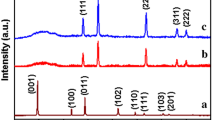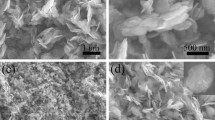Abstract
NiO nanosheets are prepared by calcination of nickel hydroxide nanosheets, obtained by the hydrolysis of trans-bis(acetato-κO)bis(2-aminoethanol-κ2 N,O)nickel(II) complex. BET analysis reveals the presence of a high specific surface area of 48 m2g−1 and a pore volume of 0.26 cm3g−1 after calcination at 400 °C. The two-dimensional NiO nanostructure undergoes a reversible lithium ion uptake and release revealing an initial unexpectedly high capacity of ~1100 mAhg−1 at a cycling current of 400 mAg−1, exceeding the theoretical capacity of NiO (718 mAhg−1). We attribute this high storage capacity to the advantageous two-dimensional morphology of the sample, namely to the presence of agglomerates composed of NiO nanosheets, allowing a pronounced Li-ion storage through the insertion mechanism and by the formation of a polymer-like layer at the samples internal surfaces. However, after 20 cycles the recovered capacity diminishes rapidly due to the onset of Li-ion intercalation into NiO, which is found less reversible. In addition, an increase in the charge transfer resistance and increase in the electrode polarization, measured by differential capacity, contribute to the analyzed capacity decay upon continuous cycling.








Similar content being viewed by others
References
Poizot P, Laruelle S, Grugeon S, Dupont L, Tarascon JM (2000) Nano-sized transition-metaloxides as negative-electrode materials for lithium-ion batteries. Nature 407(6803):496–499
Cabana J, Monconduit L, Larcher D, Palacin MR (2010) Beyond intercalation-based li-ion batteries: the state of the art and challenges of electrode materials reacting through conversion reactions. Adv Mater 22(35):E170–E192
Grugeon S, Laruelle S, Herrera-Urbina R, Dupont L, Poizot P, Tarascon JM (2001) Particle size effects on the electrochemical performance of copper oxides toward lithium. J Electrochem Soc 148(4):A285–A292
Liu H, Wang G, Liu J, Qiao S, Ahn H (2011) Highly ordered mesoporous NiO anode material for lithium ion batteries with an excellent electrochemical performance. J Mater Chem 21(9):3046–3052
Ma J, Yang J, Jiao L, Mao Y, Wang T, Duan X, Lian J, Zheng W (2012) NiO nanomaterials: controlled fabrication, formation mechanism and the application in lithium-ion battery. Cryst Eng Commun 14(2):453–459
Wang X, Qiao L, Sun X, Li X, Hu D, Zhang Q, He D (2013) Mesoporous NiO nanosheet networks as high performance anodes for Li ion batteries. J Mater Chem A 1(13):4173–4176
Wang X, Li X, Sun X, Li F, Liu Q, Wang Q, He D (2011) Nanostructured NiO electrode for high rate Li-ion batteries. J Mater Chem 21(11):3571–3573
Wang X, Yang Z, Sun X, Li X, Wang D, Wang P, He D (2011) NiO nanocone array electrode with high capacity and rate capability for Li-ion batteries. J Mater Chem 21(27):9988–9990
Poizot P, Laruelle S, Grugeon S, Dupont L, Tarascon JM (2000) From the vanadates to 3d-metal oxides negative electrodes. Ionics 6(5–6):321–330
Laruelle S, Grugeon S, Poizot P, Dollé M, Dupont L, Tarascon JM (2002) On the origin of the extra electrochemical capacity displayed by MO/Li cells at low potential. J Electrochem Soc 149(5):A627–A634
Dolle M, Poizot P, Dupont L, Tarascon J-M (2002) Experimental evidence for electrolyte involvement in the reversible reactivity of CoO toward compounds at low potential. Electrochem Solid-State Lett 5(1):A18–A21
Yuan L, Guo ZP, Konstantinov K, Munroe P, Liu HK (2006) Spherical clusters of NiO nanoshafts for lithium-ion battery anodes. Electrochem Solid-State Lett 9(11):A524–A528
Seifollahi Bazarjani M, Kleebe H-J, Müller MM, Fasel C, Baghaie Yazdi M, Gurlo A, Riedel R (2011) Nanoporous silicon oxycarbonitride ceramics derived from polysilazanes in situ modified with nickel nanoparticles. Chem Mater 23(18):4112–4123
Seifollahi Bazarjani M, Foro S, Donner W, Gurlo A, Riedel R (2012) trans-Bis (acetato-O) bis (2-aminoethanol-2N, O) nickel (II). Acta Crystallogr Sect E: Struct Rep Online 68(5):m567–m568
Sing KSW, Everett DH, Haul RAW, Moscou L, Pierotti RA, Rouquerol J, Siemieniewska T (1985) Reporting physisorption data for gas solid systems with special reference to the determination of surface-area and porosity (Recommendations 1984). Pure Appl Chem 57(4):603–619. doi:10.1351/pac198557040603
Kaspar J, Graczyk-Zajac M, Riedel R (2012) Carbon-rich SiOC anodes for lithium-ion batteries: part II. Role of thermal cross-linking. Solid State Ionics 225:527–531
Kaspar J, Graczyk-Zajac M, Riedel R (2013) Lithium insertion into carbon-rich SiOC ceramics: influence of pyrolysis temperature on electrochemical properties. J Power Sources 244:450–455
Zhu Y, Cao C, Tao S, Chu W, Wu Z, Li Y (2014) Ultrathin nickel hydroxide and oxide nanosheets: synthesis, characterizations and excellent supercapacitor performances. Sci Rep 4:5787
Pascale F, Tosoni S, Zicovich-Wilson C, Ugliengo P, Orlando R, Dovesi R (2004) Vibrational spectrum of brucite, Mg(OH)2: a periodic ab initio quantum mechanical calculation including OH anharmonicity. Chem Phys Lett 396(4–6):308–315
Hall DS, Lockwood DJ, Poirier S, Bock C, MacDougall BR (2012) Raman and infrared spectroscopy of α and β phases of thin nickel hydroxide films electrochemically formed on nickel. J Phys Chem A 116(25):6771–6784
Passerini S, Scrosati B, Gorenstein A (1990) The intercalation of lithium in nickel oxide and its electrochromic properties. J Electrochem Soc 137(10):3297–3300
Acknowledgements
This work was financially supported by the Deutsche Forschungsgemeinschaft (DFG), Bonn, Germany, within the priority Program SPP1473/JP8. The authors thank C. Loho for his help with XRD measurements, M. Colmenares and C. Goebel for the TEM characterization, U. Kunz for the SEM micrographs and K. Wissel for her support in the electrode and testing cell preparation. JK thanks Prof. S. Passerini for the helpful discussion on the electrochemical data at the ISE annual meeting 2014.
Author information
Authors and Affiliations
Corresponding author
Additional information
Dedicated to Dr. Mahdi Seifollahi Bazarjani.
Mahdi Seifollahi Bazarjani: Deceased in February 2015.
Rights and permissions
About this article
Cite this article
Kaspar, J., Bazarjani, M.S., Schitco, C. et al. Electrochemical study of NiO nanosheets: toward the understanding of capacity fading. J Mater Sci 52, 6498–6505 (2017). https://doi.org/10.1007/s10853-017-0885-0
Received:
Accepted:
Published:
Issue Date:
DOI: https://doi.org/10.1007/s10853-017-0885-0




